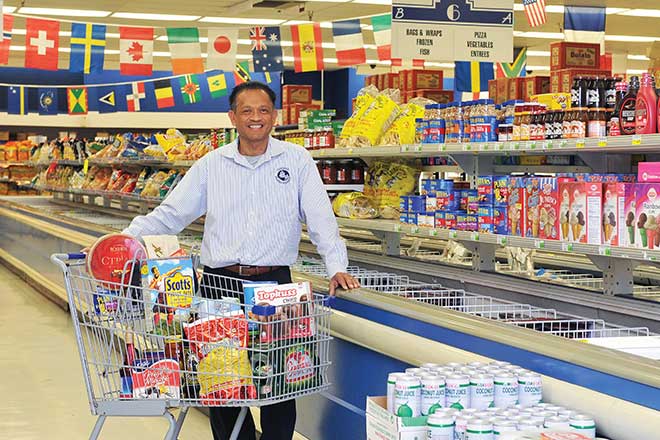when » 8 a.m. to 9 p.m. daily
where » 421 N. Kirkwood Road
why » To peruse a wide array of international ingredients or try something new
From the outside, Kirkwood’s Global Foods Market looks like any other grocery store. But the second you walk in the door, the international flags hanging from the ceiling tell you you’ve landed somewhere unique. Aisle after aisle display more than 45,000 ingredients from every corner of the globe: whether you’re searching for curry paste, rosewater, Turkish labneh, European-style breads and sausages, real U.K. Cadbury or even uncommon cuts of meat, you’ll probably find it here.
The family-run shop has been a Kirkwood mainstay since it opened in 1999. Owner Suchin Prapaisilp, who immigrated from Thailand in the ’70s, had previously been a co-owner of South Grand’s Jay International Foods, one of the first international grocery stores in the city. “He thought there was an opportunity to grow the international market into a bigger footprint,” says Prapaisilp’s son Shayn, who is the company’s vice president. “When he found out a national grocery store was going out of business in Kirkwood, he saw it as his big chance.” The family also owns The King & I on South Grand, as well as United Provisions in the Loop and two Oishi restaurants.
To stock its shelves, Global Foods Market works with 70 to 100 suppliers and takes its cues from its customers. “Oftentimes, we’re seeking out small distributors who are the only ones carrying what they’re carrying,” Prapaisilp says. It’s not uncommon, he adds, for no one to speak English at the companies they work with. “There’s a Polish company out of Chicago that we knew had frozen pierogies, so we kept calling,” he says. “Finally we got to talk to someone, and it ended up being their high school son—he was the only one who spoke English, and he negotiated prices with us.”
Not surprising, the market is popular with immigrants and foreign nationals who seek a small taste of home. “St. Louis has dozens of different ethnic groups, ranging from large Chinese and Indian populations numbering in the tens of thousands down to smaller groups of just 60 or 70,” Prapaisilp says. He explains the market has a longstanding relationship with the International Institute, which notifies it when a new group is resettling in St. Louis so the market can smooth the transition to a new home by stocking some of their native foods. “St. Louis as a whole has become so much more diverse—before, we only sold Asian foods and now you’ll see products from South America, West Africa and all over,” Prapaisilp notes.
Of course, the market is popular with the general population, too, especially since it often is one of the first to carry ingredients trending on the coasts, Prapaisilp says. For example, Global Foods Market claims to be the first to have brought kimchi here a decade ago. “Before, only Koreans would buy it and now people are putting it even on burgers,” Prapaisilp says. And a wide variety of ancient grains, another food trend, also can be found here. “It was just quinoa a few years ago, but now there’s farro, amaranth and other atypical grains. We carry dozens of varieties. You can drive all around the country and find very few stores offering the breadth of product we have here.”
Pictured: Suchin Prapaisilp
Photo: Bill Barrett








